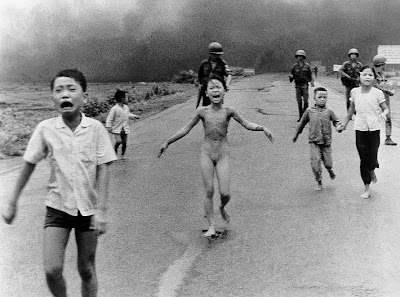You watched excerpts from
"Born on the Fourth of July" today. Please remember that I'm going to be doing homework checks on material that you covered while I was in Montreal this week. Your
Chapter 7 Key Terms and Questions are due on November 12th.
Your
Vietnam War Assignment is due on November 14th. Your
Chapter 7 Test is on Monday, November 17th.
The study guide for this test is below.
A. PEOPLE
Identify and explain the role each played in the Vietnam War
1. Ho Chi Minh
2. Ngo Dinh Diem
3. Lyndon B. Johnson
4. Richard M. Nixon
5. Viet Minh
6. Viet Cong
7. Le Duc Tho
8. Henry Kissinger
9. William Westmoreland
10. "Draft Dodger"
B. CONCEPTS/TERMS
Explain the significance of the following with regards to the Vietnam War (identify participants or individuals if appropriate)
1. Ho Chi Minh Trail
2. defoliation
3. "search and destroy" mission
4. "Vietnamization of the war"
5. Gulf of Tonkin Incident
6. My Lai Massacre
7. domino theory
8. Kent State University protest (May 4, 1970)
9. Tet Offensive (January 1968)
10. Geneva Agreement (1954)
C. ISSUES
Provide the information requested
1. The predominant religion of Vietnam
2. The battle which marked the end of French colonial rule in Indo-China
3. The scandal which led to the only resignation of an American President
4. The Vice President who replaced the President after his resignation
5. Why was November 1963 a "bad month" for the governments of South Vietnam and the United States?
As we will see, public support for the Vietnam War changes over time as more and more American soldiers are killed. We see a growth in the anti-Vietnam War demonstrations, and the media also played a role in the turn of popular opinion against the war. I REALLY recommend that you
have a look at the this series of photographs from the Vietnam War era, pretty powerful imagery (make sure that you read the captions too).
Here is a link to the NPR that explains the story behind the photograph below, definitely worth the time to read or listen to the podcast, and make sure that you look at the photo gallery of Eddie Adams' photographs of the Vietnam War.

There are certain iconic images associated with the Vietnam War. Here is another:

The above photograph is of Phan Thị Kim Phúc, O.Ont (born in 1963), she is a Vietnamese-Canadian best known as the child subject of a Pulitzer Prize winning photograph taken during the Vietnam War on June 8, 1972. The iconic photo taken in Trang Bang by AP photographer Nick Ut shows her at about age nine running naked on the street after being severely burned on her back by a South Vietnamese napalm attack. Contrary to popular myth, the US Air Force were not involved in the attack, and only two US troops were within 60 miles (97 km) of the scene, neither of whom had any say in the bombings. Still, it is a powerful image associated with the war.
I'm posting the study guide for your
Chapter 7 Test (Cold War Exam) below. You have a lot of review and studying to do, that's why I'm posting this study guide so far in advance (this test is on
November 17th).
It is a multiple choice test with
70-75 multiple choice questions. Please make sure that you have read Chapter 7. Here are some other study tips:
- study "The Origins of the Cold War (ppt)"
- study all notes on the Origins and Causes of the Cold War
- study notes on the Korean War
- study notes on the Cuban Missile Crisis
- study notes on the Vietnam War (see notes package and Vietnam War booklet, and the notes that I sent to you on the Vietnam War)
- make sure that you know all the Cold War Concepts
- know the chronology of events of the Cold War (study the Cold War timeline and the Vietnam War timeline, and the end of the Cold War timeline that I will be giving you in subsequent class)
- know key events that we've emphasized in class (for example: Berlin Airlift, Korean War, Cuban Missile Crisis, Vietnam War) plus other key events from the timeline
- know major arms reduction agreements (bilateral agreements and multilateral agreements), please study the notes that I will give you next week on this topic.
- know about the formation of alliances (NATO, Warsaw Pact) and the formation of "spheres of influence"
- anything that I gave you as a handout is testable material and should be reviewed!!
- know how the Cold War ends and its results/consequences
You had the entire class period to work on your
Latin American revolutionary leaders Facebook assignment. You could work with a partner on this assignment if they are covering the same leader.
This assignment is due on Friday, November 14th. Please use the
PowerPoint Facebook template that is on the
IB 20 wiki under Unit 4 Independence Movements.


